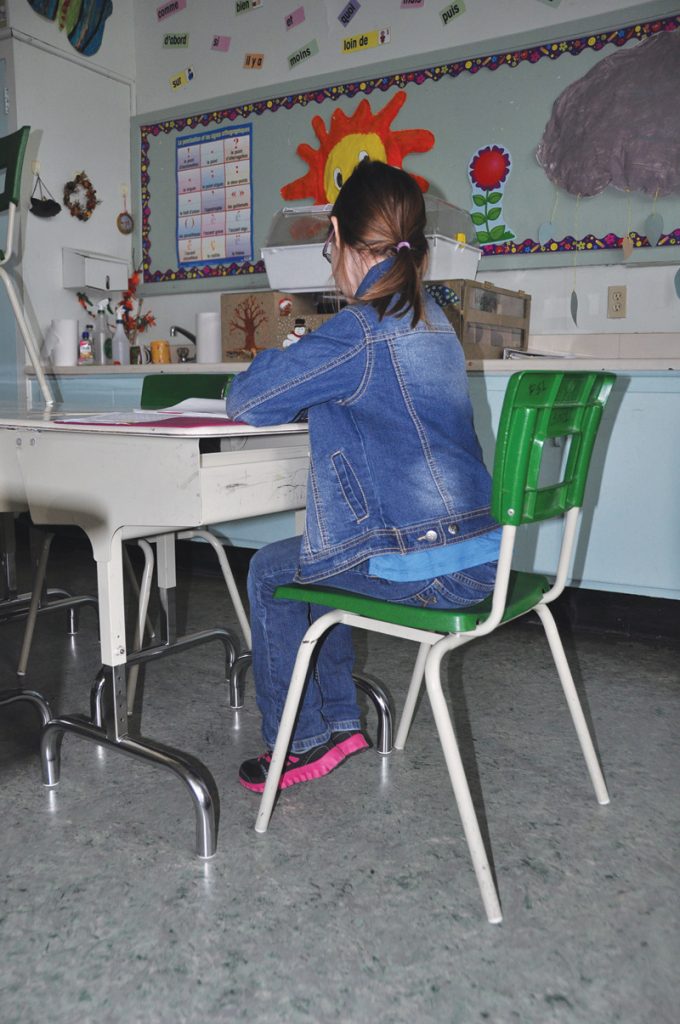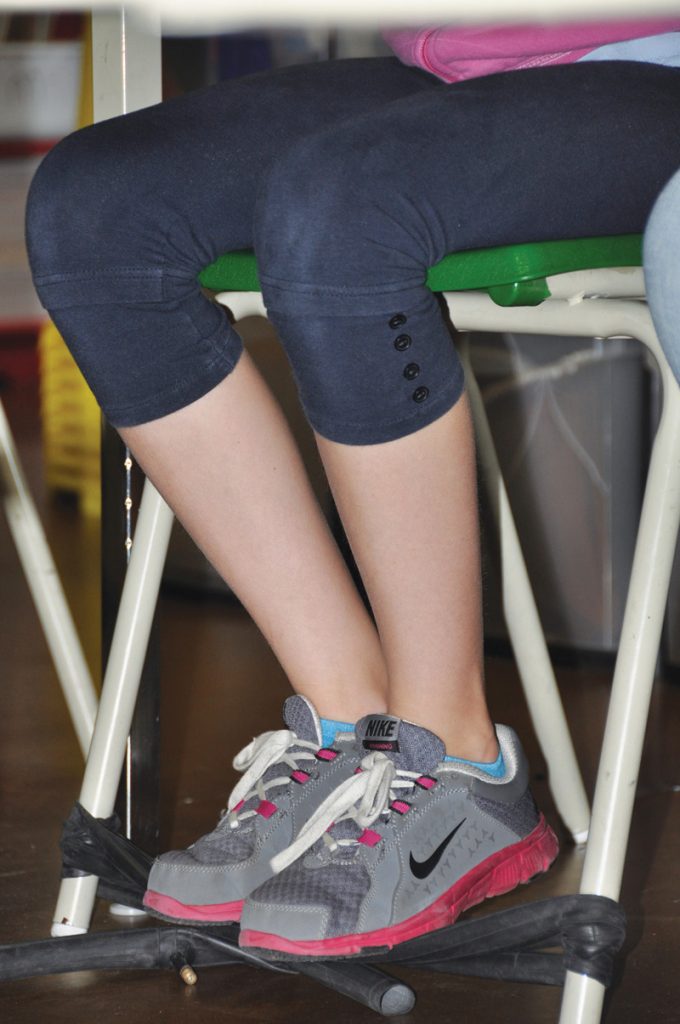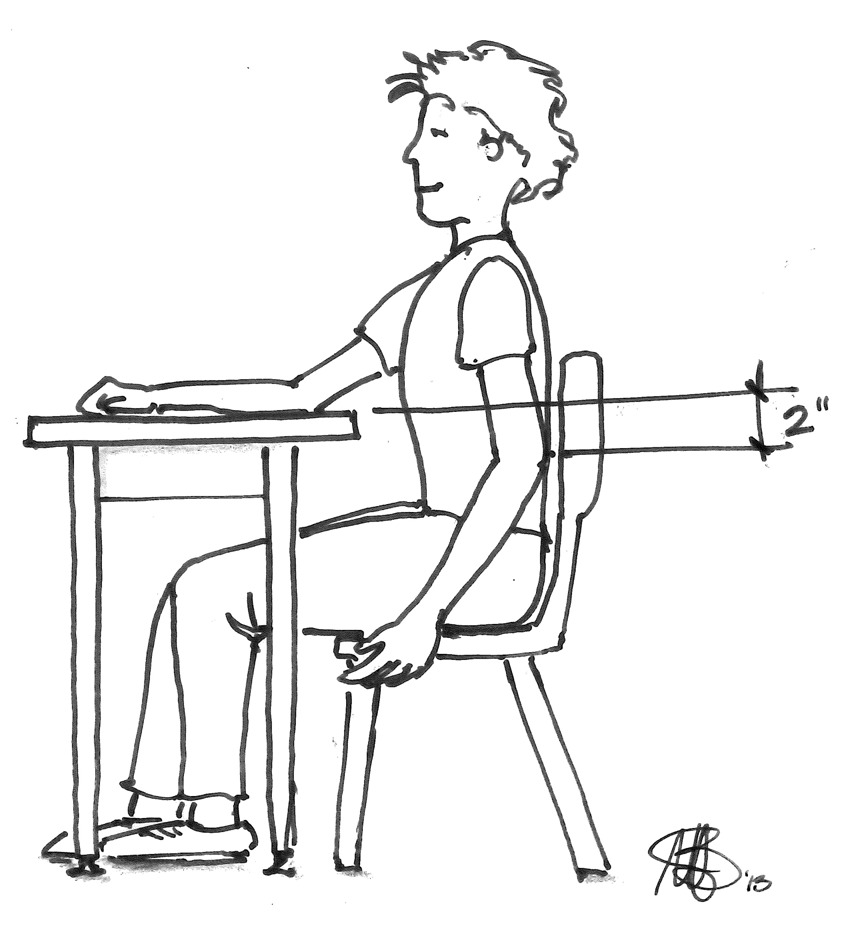New agenda, new pencils, new books, and new faces! But the story remains the same: “Sit up straight! Stop wiggling! Four chair legs on the floor!” Students’ sitting posture is not always ideal and the cause can be from different factors: weak muscles, boredom, poor awareness of their body in space, sensory issues, neurological delays, or a mismatch between body and school furniture.
Before calling in a specialist or putting the student on a wait list for assessments, start with the basics: ergonomics. Ergonomics is defined as the applied science of equipment design, as for the workplace, intended to maximize productivity by reducing operator fatigue and discomfort (thefreedictionary.com/ergonomics). The students’ classroom is their workplace and their desks and chairs are their workstations.
Take a look at the height of the desks and chairs of your students. Do they fit? Sure, the students are seated and they have a writing surface, but is the furniture ergonomic? How many students can touch the floor with their feet? Whose desks are almost below their chins? Is there a match between their bodies and the furniture?

Imagine if you had to sit a good part of your day on a chair that left your feet dangling or at a desk that was too high or too low. You may compensate by wiggling, rocking on your chair or tilting it forward, or you may just lose focus on the task. Eventually, your body may begin to feel pain or fatigue. Students who are sitting on chairs and desks not ideal for their body measurements may move more and adopt various positions to compensate: sit on their legs, rock their chair forward to touch the floor with their feet or wrap their legs around the legs of the chair. As well, poor sitting posture and poorly designed furniture in schools contributes to musculoskeletal pain in school children, especially discomfort in the neck and back (Hedge & Lueder, 2008; Lueder & Rice, 2008; Milanese & Grimmer, 2004; Mohd et al., 2010).

Figure A
Research indicates a high percentage of mismatches between students and their school furniture (Chung, 2007; Milanese & Grimmer, 2004). Chairs are too high, chairs are too small, the seat length is too long, desks are too high… Backs are unsupported because students sit on the edges of their seats to reach the floor with their feet. See Figure A above.

Figure B
Seat height and work surface height are two important considerations that must be matched to each student (Evans, Courtney, & Fok, 1988). It is important to have a chair that supports the back and allows for 90 degree flexion at the hips, the knees and the ankles for handwriting tasks; the writing surface should be two inches above the student’s bent elbow and the top of the chair should be slightly below the student’s shoulder blade (Benbow, Hanft, & Marsh, 1992). See Figure B.
In an ideal world, new chairs and height adjustable desks would be purchased. But in the real world, try finding the best-fitted chair and desk for each student and if it’s not perfect, a few low-cost modifications can be made. If the chair is still too high, add a place for the feet to rest. Reusing the inner tubes of bicycle tires and tying them tightly around the two front legs of the chair provides a place for the student to rest their feet. See Figure C.

Figure 3
Sometimes, this band can be placed on the legs of the desk depending on the desk’s design. Others prefer wrapping up old telephone books with duct tape to make a foot rest. For some, this works, others tend to kick the foot rest away. If the chair’s seat is too long, a cushion can be placed behind the student’s back to provide back support.

If a student is sitting on a therapy ball, the same principles as a chair apply for the desk height, and feet must be flat on the floor; however, knees should be slightly more than 90 degrees in order to create a slight anterior pelvic tilt (Henry, 2001). It should be noted that research results on the use dynamic sitting on therapy balls in the classroom for students with attention issues indicate that their use could be beneficial to improve attention and behaviour (Fedewa & Erwin, 2011; Schilling, Washington, Billingsley, & Deitz, 2003). Having students use the therapy ball instead of a regular chair may be worth trying in your classroom.
You’re right, it takes time to set each student’s desk at the right height and find the right sized chair. Plus you must remember to check again midyear as they’ll have grown. Although time consuming, it’s worth the investment for the sake of the students’ posture. As well, if they touch the floor and are comfortable at their desk, their attention may be better and the development of muscle pain or fatigue can be prevented. Once classroom furniture is better suited to student needs, learning is fostered. Children are developing postural habits in school and should learn about the importance of ergonomics. This will protect them when they are adults. And, as we know, it is easier to learn good habits than unlearn bad ones.
References
Benbow, M., Hanft, B., & Marsh, D. (1992). Handwriting in the classroom: improving written communication. In C. Brasic Royeen (Ed.), AOTA Self Study Series: Classroom Applications for School-Based Practice. Rockville, MD: AOTA.
Chung, J. (2007). Anthropometric evaluation for primary school furniture design. Ergonomics, 50(3), 323-334.
Evans, W. A., Courtney, A. J., & Fok, K. F. (1988). The design of school furniture for Hong Kong schoolchildren. An anthropometric case study. Applied Ergonomics, 19(2), 122-134.
Fedewa, A., & Erwin, H. (2011). Stability balls and students with attention and hyperactivity concerns: implications for on-task and in-seat behavior. The American Journal of Occupational Therapy, 65(4), 393-399.
Hedge, A., & Lueder, R. (2008). School furniture for children. In R. Lueder & V. J. Berg Rice (Eds.), Ergonomics for Children: Designing Products and Places for Toddlers to Teens (pp. 721-751). Boca Raton, FL: Taylor and Francis Group.
Henry, D. (2001). Tool Chest: for teachers, parents, and students. Youngtown, AZ: Henry Occupational Therapy Services, Inc.
Lueder, R., & Rice, V. (2008). Physical development in children and adolescents and age-related risks. In R. Lueder & V. J. Berg Rice (Eds.), Ergonomics for Children: Designing Products and Places for Toddlers to Teens (pp. 187-225). Boca Raton, FL: Taylor and Francis Group.
Milanese, S., & Grimmer, K. (2004). School furniture and the user population: an anthropometric perspective. Ergonomics, 47(4), 416-426.
Mohd, A., Zailina, H., Shamsul, B., Nurul, A., Mohd, A., & Syazwan, A. (2010). Neck, upper back, and lower back pain and associated risk factors among primary school children. Journal of Applied Science, 10(5), 431-435.
Schilling, D. L., Washington, K., Billingsley, F. F., & Deitz, J. (2003). Classroom seating for children with attention deficit hyperactivity disorder: therapy balls versus chairs. The American Journal of Occupational Therapy, 57(5), 534-541.
ABOUT THE AUTHOR
Caroline Hui
Caroline Hui, erg. OT(C) has over 20 years experience in pediatrics and works as a private clinician in the Eastern Townships, QC. She is currently completing her Master’s degree at McGill University.
This article is from Canadian Teacher Magazine’s Sept/Oct 2013 issue.












